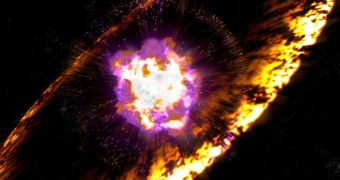A new paper in the scientific journal Nature Physics details the use of laser beams to recreate supernova explosions in controlled, laboratory conditions.
The experiments, spearheaded by scientists with the Oxford University in the United Kingdom, were intended to help researchers paint a more accurate picture of such cosmic events.
In their paper in the journal Nature Physics, the scientists who worked on this project detail that supernova explosions are among the most energetic events until now documented to take place anywhere in the Universe.
They occur either when nuclear fusion reignites within a degenerate star or when the core of a massive star collapses, and have been shown to birth a massive detonation shock wave, EurekAlert informs.
The Oxford University scientists and their colleagues explain that, although the same principles and events are at play, these cosmic events are sometimes different from one another, meaning that some take fairly odd shapes.
Hoping to solve this puzzle, specialists employed laser beams to recreate such cosmic events in the laboratory and study their behavior, and found that interstellar mater from supernova explosions does not always expand uniformly.
As part of their experiments, the researchers focused three laser beams onto a carbon rod target whose thickness was similar to that of a strand of hair. When heated by the lasers to millions of degrees Celsius, the rod exploded.
Due to the fact that the rod was placed in a chamber that was filled with a low-density gas and that also accommodated for a plastic grid mimicking dense gas clouds found in space, the explosion of the carbon rod was not a uniform one.
“The experiment demonstrated that as the blast of the explosion passes through the grid it becomes irregular and turbulent just like the images from Cassiopeia [i.e. a supernova explosion in the Cassiopeia constellation],” says Professor Gianluca Gregori.
Furthermore, “This result confirms that the idea that supernova explosions expand into uniformly distributed interstellar material isn't always correct and it is consistent with both observations and numerical models of a Shockwave passing through a ‘clumpy’ medium.”
While some might argue that trying to research cosmic events by recreating them in laboratory conditions is a futile endeavor, Professor Gianluca Gregori and fellow researchers maintain that their experiment did not lack accuracy.
“It may sound surprising that a table-top laboratory experiment that fits inside an average room can be used to study astrophysical objects that are light years across,” the Oxford University specialist wished to stress.
Furthermore, “In reality, the laws of physics are the same everywhere, and physical processes can be scaled from one to the other in the same way that waves in a bucket are comparable to waves in the ocean. So our experiments can complement observations of events such as the Cassiopeia A supernova explosion.”

 14 DAY TRIAL //
14 DAY TRIAL //